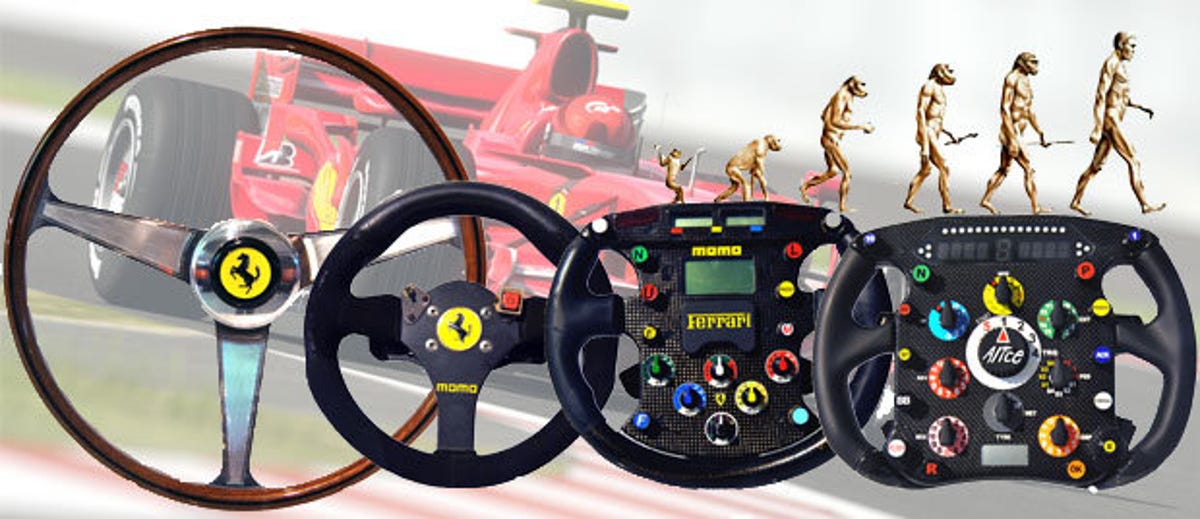Ferrari Formula One steering wheel's evolution in photos
In Ferrari's hands, the F1 steering wheel has evolved exponentially to become a full-on computer system that can cost upwards of £100,000. We steer some history.

Ah, the humble steering wheel -- circular apparatus designed to manoeuvre modern land vehicles right or left, correct? Wrong. It may have started that way, but in Ferrari's hands, the F1 steering wheel has evolved exponentially to become a full-on computer system that can cost upwards of £100,000. Each.
During a recent trip to the Galleria Ferrari museum in Maranello, Italy, we had the opportunity to go hands on with several slices of F1 history. The first of these was the enormous wheel on the 1963 Ferrari 156 F1-63. This model had a circumference roughly as large as the Moon and was built of wood and metal. If you were unfortunate enough to smack your head on one during an accident, it would leave quite a bruise. Not to mention a touch of internal haemorrhaging. Or a sprinkling of death.
Ferrari stepped things up a notch In 1989 with the steering wheel for its F1-89 car (photo 3, above). This model was considerably smaller, used rubbery material that was easier to grip and was safer in the event of an accident. The wheel incorporated some fancy new technology, too. We say fancy -- it was a button and a solitary switch, but it was the inspiration Ferrari needed to take steering wheel technology to new extremes.
Ten years later, Ferrari fitted an even more advanced steering wheel for Michael Schumacher's F399 race car (photo 4). The car itself was a heck of a lot more complex than the F1-89. The sport now had a raft of new rules, so the interface between driver and car had to move with the times.
It was made from lightweight, super-strong carbon fibre and featured a central display to indicate a variety of settings. Crucially, it also came with gear shifter paddles on the rear -- one to shift down a gear and another to shift up -- so drivers needn't take their hands off the wheel to change gear. A big green N allowed the driver to select neutral, while the large L button engaged the pit lane speed limiter, preventing the car exceeding a certain speed when entering the pits.
That steering wheel also had a radio button, which opened two-way radio communications between a driver and his pit crew and, for the first time, the wheel allowed the driver to control the fuel mixture on the fly. This adjusted the air-fuel ratio to create either a lean burn, where the mixture has considerably less fuel than the norm, or a rich mixture, which burns more fuel but offers more performance.
Fast forward another nine years to 2008, and Ferrari had evolved its F1 steering wheel even further (photo 5). It too had an LED display, but it also featured a strip of lights across the top that lit up in succession to indicate engine revs and the point at which the driver should change gear.
Below this, it had three very important dials, labelled 'in', 'mid' and 'exit'. These adjusted the car's differential (the device that transmits power to the rear wheels while allowing them to rotate at different speeds) to change handling characteristics during the entry, middle and exit of a corner. If a driver believes his car is suffering from understeer (where the car ploughs straight on instead of going round the corner), for example, he can adjust the in dial to correct this behaviour. The same applies to the mid and exit dials.
By this time, Ferrari had also introduced a drinks delivery system that piped a cooling beverage from a reservoir, via a tube, to a nozzle in the driver's helmet. The Formula One car is a tremendously inhospitable place where drivers endure cockpit temperatures in excess of 40 degrees Celsius and lose around 3kg in sweat over a race, so this inclusion was a godsend. The driver usually has a choice of beverage, and many opted for something tea-like and sugary that tasted good both when cold and when heated as a result of being in the oven-like cockpit for an hour and a half.
The modern F1 steering wheel also allows the driver to limit the number of engine revs and adjust the brutality of the car's power delivery for dry or wet conditions. The latter is crucial, as the last thing a driver wants is to plant the throttle coming out of a wet corner and have the wheels spin so violently he loses complete control.
We think it's amazing that F1 drivers are able to remember and execute all these functions (and more) while doing speeds that would make most human beings lose their lunch. Drivers, it would seem, aren't just drivers any more -- they're also a bunch of highly trained nerds that deserve respect from petrolheads and geeks alike.
Click through our photo gallery above to see how Ferrari's F1 steering wheels have progressed through the ages, then let us know your thoughts in the comments below.